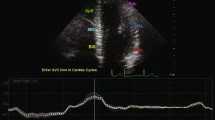Summary
To assess the normal value of left ventricular twist (LVtw) and examine the changes with normal aging by 2-dimensional ultrasound speckle-tracking imaging (STI), 121 healthy volunteers were divided into three age groups: a youth group (19–45 y old), a middle-age group (46–64 y old) and an old-age group (≥65 y old). Basal and apical short-axis images of left ventricular were acquired to analyse LV rotation (LVrot) and LVrot velocity. LVtw and LVtw velocity was defined as apical LVrot and LVrot velocity relative to the base. Peak twist (Ptw), twist at aortic valve closure (AVCtw), twist at mitral valve opening (MVOtw), untwisting rate (UntwR), half time of untwisting (HTU), peak twist velocity (PTV), time to peak twist velocity (TPTV), peak untwisting velocity (PUV), time to peak untwisting velocity (TPUV) were separately measured. The results showed that the normal LV performs a wringing motion with a clockwise rotation at the base and a counterclock-wise rotation at the apex (as seen from the apex). The LVtw velocity showed a systolic counterclock-wise twist followed by a diastolic clockwise twist. Peak twist develops near the end of systole (96%±4.2% of systole). With aging, Ptw, AVCtw, MVOtw, HTU and PUV increased significantly (P<0.05) and UntwR decreased significantly (P<0.05). However, no significant differences in TPUV, PTV and TPTV were noted among the 3 groups (P>0.05). It is concluded that LV twist can be measured non-invasively by 2-dimensional ultrasound STI imaging. The age-related changes of LVtw should be fully taken into consideration in the assessment of LV function.
Similar content being viewed by others
References
Harvey W. An anatomical disposition on the motion of the heart and blood in animals, 1628. In: Willis F A, Keys T E. eds. Cardiac Classics. London, England: Henry Kimpton, 1941.19–79
Nagel E, Stuber M, Burkhard B et al. Cardiac rotation and relaxation in patients with aortic valve stenosis. Eur Heart J, 2000,21:582–589
Young A A, Kramer C M, Ferrari V A et al. Three-dimensional left ventricular deformation in hypertrophic cardiomyopathy. Circulation, 1994,90:854–867
Chung J, Abraszewski P, Yu X et al. Paradoxical increase in ventricular torsion and systolic torsion rate in type 1 diabetic patients under tight glycemic control. J Am Coll Cardiol, 2006,47:384–390
Dong S, Hees P, Hees P et al. MRI assessment of LV relaxation by untwisting rate: a new isovolumic phase measure of tau. Am J Physiol Heart Circ Physiol, 2001,281:H2002–H2009
Meunier J, Bertrand M. Ultrasonic texture motion analysis:theory and simulation. IEEE Trans Med Imaging, 1995,14:293–300
Taber L A, Yang M, Podszus W W. Mechanics of ventricular torsion. J Biomechanics, 1996,29:745–752
Torrent-Guasp F, Buckberg G D, Clemente C et al. The structure and function of the helical heart and its buttress wrapping. The normal macroscopic structure of the heart. Semin Thorac Cardiovasc Surg, 2001, 13:301–319
Stevens C, Remme E, LeGrice I et al. Ventricular mechanics in disastole:material parameter sensitivity. J Biomech, 2003,36:737–748
Luo A G, Yin L X, LI C M et al. Measure of left ventricular torsion with cardiac pacing and right bundle branch block patients by two-dimension ultrasound speckle tracking imaging. Chin J Ultrasonogr (Chinese), 2006,15:641–645
Takeuchi M, Nakai H, Kokumai M et al. Age-related changes in left ventricular twist assessed by two-dimensional speckle-tracking imaging. J Am Soc Echocardiogr, 2006,19:1077–1084
Notomi Y, Srinath G, Shiota T et al. Maturational and adaptive modulation of left ventricular torsional biomechanics: Dopple tissue imaging observation from infancy to adulthood. Circulation, 2006,113,2524–2533
Oxenham H C, Young A A, Cowan B R et al. Age-related changes in myocardial relaxation using three-dimensional tagged magnetic resonance imaging. J Cardiovasc Magn Reson, 2003,5:421–430
Author information
Authors and Affiliations
Rights and permissions
About this article
Cite this article
Zhang, L., Xie, M., Fu, M. et al. Assessment of age-related changes in left ventricular twist by two-dimensional ultrasound speckle tracking imaging. J. Huazhong Univ. Sci. Technol. [Med. Sci.] 27, 691–695 (2007). https://doi.org/10.1007/s11596-007-0619-7
Received:
Issue Date:
DOI: https://doi.org/10.1007/s11596-007-0619-7




